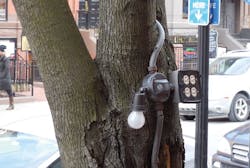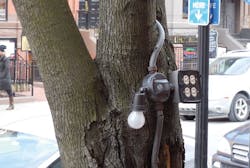What's Wrong Here? Hint: This might just burst your bubble.
How well do you know the Code? Think you can spot violations the original installer either ignored or couldn't identify? Here's your chance to moonlight as an electrical inspector and second-guess someone else's work from the safety of your living room or office. It's your turn to identify the violation.
Hint: This might just burst your bubble.
December Winners
Our three winners this month were: Jeffrey L. Masters, P.E., an electrical engineer with Wunderlich-Malec Engineering in Minnetonka, Minn.; Bill Petrovic, a design engineer with Aschinger Electric in Fenton, Mo.; and Ryan Kondracki, a project engineer with AMA Consulting Engineers, P.C. in New York. Each one of them knew that it doesn’t matter if this receptacle is installed in a dwelling unit or some other occupancy — it needs to be GFCI-protected.
For dwelling units, Sec. 210.8(A)(7) requires GFCI protection for 125V, 15A or 20A receptacles that are installed within 6 ft of the outside edge of the sink. For other than dwelling units, Sec. 210.8(B)(5) notes the same GFCI protection requirements for those receptacles.
Installing a GFCI-type receptacle would satisfy this requirement, but some people may feel that the freezer would hinder access to the receptacle. This might violate the requirement in Sec. 210.8 that it be readily accessible. Another possible solution would be to feed this receptacle through another GFCI device upstream or protect the entire circuit with a GFCI-type circuit breaker.
In closing, I can assure you this receptacle had absolutely no GFCI protection of any kind.
About the Author

Russ LeBlanc
Owner
Russ started in the electrical trade as an apprentice in 1985. He worked his way up to become a Journeyman Electrician and then eventually became a Master Electrician and Licensed Construction Supervisor. In 1999 Russ become an Electrical Instructor for The Peterson School of Engineering in Massachusetts where he developed his passion for teaching, and quickly became Department Head of Electrical Instruction. Russ has taught thousands of apprentices, electricians, engineers, inspectors, and other electrical professionals during his career as an instructor. He continues to provide electrical professionals with Electrical Code seminars, Arc-Flash Awareness training seminars and educational material through his LeBlanc Consulting Services in North Reading, MA whose specialty is educating electricians. He has been an active member of the NFPA Electrical Section and has authored hundreds of National Electrical Code proposals and comments which have become Code rules to improve the safety for the electrical industry. Russ is also an IAEI certified Electrical Inspector.
Please visit www.russleblanc.net for more information.


